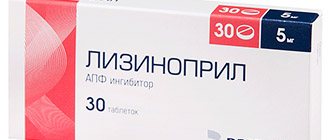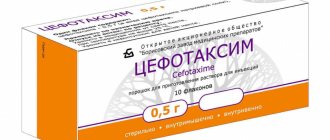Instructions for use of Lisinopril
In the process of developing hypertension, stimulation of the renin-angiotensin-aldosterone system (RAAS), which is responsible for the concentration of water, electrolytes and vascular tone, plays an important role.
Various structural mechanisms are involved in the regulation of vascular tone:
- various parts of the central nervous system (CNS);
- peripheral fibers of the autonomic nervous system;
- humoral factors (RAAS, sympathoadrenal, kalikrein-kinin system);
- prostaglandins are powerful vasoconstrictors (cause vasoconstriction);
- prostacyclins - dilate arterioles.
The RAAS is presented as a complex combination of enzymes and hormones, the main components of which are:
- angiotensinogen;
- renin;
- angiotensins I and II;
- receptors on the vascular wall that are sensitive to angiotensin II.
There are two main theories in the development of hypertension:
- Dysfunction of nervous regulation. Occurs against the background of insufficiency of hormonal mechanisms influencing the tone of arterioles, previous kidney diseases, age-related changes in blood vessels, endocrine disorders during menopause.
- Imbalance between pressor and depressor influences. An increase in the tone of the vascular wall occurs against the background of depletion of the depressor effects of the kidneys.
As a result of the above violations, the following occurs:
- volume overload of the vascular bed;
- increased cardiac output (CO);
- hyperstimulation of the sympathetic nervous system (SNS);
- renal dysfunction;
- increase in total peripheral vascular resistance (TPVR).
Volume overload of the vascular bed develops due to the accumulation of Na ions in the plasma and the vessel wall, which entails its swelling, the lumen narrows and the peripheral vascular resistance increases. Na ions increase the sensitivity of the smooth muscle layer of the vessel to angiotensin II and norepinephrine. Through narrowed arterioles, blood enters the organs in smaller quantities (relative hypovolemia). In response to this, the heart is forced to contract stronger and more often (as a result of activation of the SNS). Norepinephrine also causes spasm of the smooth muscles of arterioles, which provokes an even greater increase in blood pressure.
Prolonged spasm of arterioles in the kidneys causes a drop in pressure in the capillaries supplying the juxtaglomerular apparatus (JGA). In order to compensate for hypoxia, JGA releases renin into the bloodstream, which, under the action of angiotensin-converting enzyme (ACE), forms a substance that persistently constricts blood vessels - angiotensin II.
Mechanism of action of angiotensin II:
- interacts with special receptors on the myocytes of the blood vessels of the kidneys, lungs, liver, aorta, spleen, brain, adrenal glands;
- stimulates the vascular-motor center in the posterior part of the brain;
- increases the secretion of norepinephrine;
- influence on the functioning of the medullary layer of the adrenal glands (even more adrenaline enters the bloodstream) and cortical layer (secretion of aldosterone, which increases the retention of Na and water by the kidneys;
- independently activates the absorption pathways of Na and water in the tubules, bypassing the participation of aldosterone.
What kind of drug is this and what does it help with?
Lisinopril is an antihypertensive drug with a long-term effect, belonging to the group of angiotensin-converting enzyme inhibitors (ACE inhibitors). The drug is a representative of class III (a hydrophobic metabolite of Enalapril).
Pharmacological classification of ACE inhibitors
| Class | A drug | Bioavailability on an empty stomach/with food | Route of elimination | Plasma protein binding | Frequency of administration (per day) |
| Class I (lipophilic) | Captopril | 75%/35% | Liver – 10% Kidneys – 90% | 25-30% | 3 |
| Class IIa (lipophilic with predominantly renal elimination) | Quinapril | 38%/38% | Liver – 50% Kidneys – 50% | 97% | 2 |
| Perindopril | 65%/65% | Liver – 10% Kidneys – 90% | 20% | 2 | |
| Enalapril | 60%/60% | Liver – 10% Kidneys – 90% | 50% | 2 | |
| Class IIb (lipophilic with two elimination pathways) | Ramipril | 60%/60% | Liver – 40% Kidneys – 60% | 75% | 1 |
| Fosinopril | 36%/36% | Liver – 50% Kidneys – 50% | 95% | 1-2 | |
| Class III (hydrophilic) | Lisinopril | 25%/25% | Kidneys – 100% | 5% | 1 |
The principle of action is to block the activity of one of the key enzymes of the RAAS, which promotes the conversion of the inert form of angiotensin-I into the highly active angiotensin-II.
Actions of Lisinopril:
- stimulation of renin production and reduction of angiotensin;
- bradykinin breakdown;
- blocking aldosterone production;
- vasodilation (expansion) of arterioles and veins;
- correction of pre- and afterload on the myocardium;
- reduction of Na retention by the kidneys;
- prevents worsening dilatation of the left ventricular (LV) cavities;
- regression of LV hypertrophy phenomena;
- decreased proliferation (growth) of smooth muscle cells in the walls of blood vessels;
- stabilization of heart rhythm (improved myocardial trophism, increased concentration of K+ and Mg+ ions in plasma);
- nephroprotection by improving blood flow in the kidneys;
- capable of reducing platelet aggregation (stimulates the secretion of prostaglandin E2, prostacyclin, endothelium-relaxing factor);
- Slowing the progression of atherosclerosis;
- Antioxidant effect;
- Optimizing glucose metabolism.
Lisinopril is the only representative of the ACE inhibitor that does not undergo metabolic transformations in tissues and is completely eliminated by the kidneys without changing its structure. The drug can be safely used in patients with decreased liver function (as it is a ready-made active drug).
Lisinopril is hydrophilic; this means that for its transportation throughout the body there is practically no need to form compounds with albumin in the blood. This allows the drug to be prescribed to patients with hypoalbuminemia and combined with medications that require transport proteins (cardiac glycosides, anticoagulants, antiarrhythmics).
This medicine increases the compliance of elastic-type vascular walls (including the aorta). Lisinopril also blocks the release of protein molecules into the urine in patients with diabetes, that is, it slows down the progress of latent nephropathy.
Lisinopril has the ability to sensitize tissues to insulin, which gives it an advantage in the treatment of patients with a combination of hypertension and type II diabetes mellitus.
Due to its hydrophilic qualities, the drug practically does not dissolve and is not deposited in adipose tissue, therefore it is more preferable for use in overweight patients.
The bioavailability of Lisinopril ranges from 26-50%; food does not interfere with the absorption of the drug. The maximum concentration of the drug is detected in the blood after 6-7 hours. The half-life is 12 hours. The decrease in blood pressure begins 60 minutes after taking the tablet. The effect of treatment stabilizes after 1 month of systematic use.
This makes it possible to take a Lisinopril tablet once throughout the day and maintain a stable blood pressure level, as well as avoid morning rises in blood pressure.
Indications: why is the medicine prescribed?
Lisinopril may be the only drug in the diet or a component of complex therapy for cardiovascular pathologies.
According to studies, the use of Lisinopril stabilizes blood pressure levels in 50-80% of patients with hypertension of I and II severity.
Indications for use:
- primary and secondary forms of arterial hypertension (especially with a long history);
- chronic circulatory failure with LV systolic dysfunction;
- acute coronary syndrome (with systolic pressure above 100 mmHg);
- prevention of recurrent cardiovascular accidents in patients after AMI;
- insulin-dependent form of diabetes mellitus type II, complicated by nephropathy.
How to take and in what dosages?
It is enough to take Lisinopril once a day, optimally in the first half of the day, without being tied to meals. The best clinical effect is achieved with systematic use of the drug at the same time.
Arterial hypertension.
The initial dosage is 2.5 mg/day. To achieve a stable effect, you need to take the drug for 2-4 weeks. And only after this, if necessary, increase the dose to 10-20 mg/day within 1 week.
The usual maintenance dose is 10-20 mg (maximum daily dose is 40 mg).
It is not recommended to exceed the dosage of 40 mg; it is better to additionally prescribe an antihypertensive drug of another group.
Heart failure.
The saturation dose is 2.5 mg/day. Gradually it is brought to the average therapeutic dose of 20 mg/day.
Acute coronary syndrome.
Patients with AMI and ST segment elevation are recommended to use Lisinopril on the first day after the onset of an anginal attack.
The initial dosage is 5 mg/day, the average therapeutic dosage is 10 mg/day. In case of arterial hypotension, when SAT <100 mmHg, the dose of the drug is reduced to 2.5 mg/day.
The duration of the course is 6-7 weeks, then additional studies are required to confirm the presence of indications for further use of the drug (if LV dysfunction is detected, it is recommended to continue treatment at a dosage of 10-20 mg/day).
Nephropathy in patients with diabetes mellitus.
The starting dose of Lisinopril is 10 mg/day (maximum 20 mg/day).
In case of clinically significant renal dysfunction, the dose of Lisinopril should be calculated taking into account creatinine levels. Maximum - no more than 20 mg/day.
In some clinical cases it is worth increasing the intervals between doses to 48 hours.
To better stabilize blood pressure, it is advisable to combine Lisinopril with diuretics (Hydrochlorothiazide, Indopamide).
Contraindications for use and symptoms of overdose
Contraindications to the use of Lisinopril:
- Absolute: Pregnancy and breastfeeding.
- Bilateral narrowing of the renal arteries.
- Quincke's edema.
- Primary hyperaldosteronism.
- Intolerance or allergy to any of the components of the drug.
- Severe stenosis of the aortic and mitral valves.
- Obstructive form of hypertrophic cardiomyopathy (HCM).
- Anuria.
- Arterial hypotension (SAT below 70 mmHg).
- Cardiogenic shock.
- Diffuse connective tissue pathology (dermatomyositis, systemic lupus erythematosus, nodular and rheumatoid polyarthritis, scleroderma).
If you suspect poisoning with Lisinopril, you must immediately stop treatment, induce vomiting, take a sorbent, lay the patient horizontally with the head and legs raised, and urgently call an ambulance.
Side effects
In general, Lisinopril is well tolerated by patients - the reactions that occur are mild and do not require discontinuation of use of the drug.
Possible adverse reactions:
- Arterial hypotension (often the “first dose effect”), dizziness with a sudden change in body position, palpitations, general malaise, blurred vision; In patients with AMI, II-III degree AV block and cardiogenic shock may develop within 24 hours from the onset of the attack.
- Acute renal failure, dysuric manifestations, anuria, edema.
- Decreased sexual desire, gynecomastia.
- Dry obsessive cough, shortness of breath, decreased bronchial obstruction, “burnt tongue” syndrome.
- Indigestion, epigastric discomfort, nausea, loss of appetite, distortion of taste.
- Skin rashes, redness, itching, angioedema (possibly fatal), urticaria, autoimmune reactions.
- Decrease in the number of red blood cells, platelets, leukocytosis.
- Sleep disturbance, anxiety, paresthesia, tinnitus, depression.
- Double vision, sensitivity to light, decreased visual acuity.
How does Lisinopril work?
The drug acts on the renin-angiotensin system of the heart, interfering with dilatation of the left ventricle. At the same time, there is a decrease in the load on the myocardium. The substance reduces pressure in the capillaries of the lungs, as well as in peripheral vessels. When treated with Lisinopril, the tolerance of the cardiac myocardium to increased stress increases. In addition, the activity of renil in plasma increases.
After taking a single dose, the first positive effect occurs after 50-60 minutes. The manifestation of the therapeutic effect intensifies within 7 hours and persists throughout the day. Therapy lasting for several weeks achieves the maximum possible hypotensive effect.
Eating does not interfere with the absorption of the active substance, but at the same time does not contribute to it. Therefore, taking the medicine does not depend on the time of eating. Absorption of Lisinopril reaches 25%. The drug molecules bind weakly to blood proteins. Half-life occurs after 12 hours. Substances are excreted unchanged by the kidneys. Lisinopril does not form metabolites.
Lisinopril analogs
The original Lisinopril has an affordable price, but there are still many generics (analogs of the drug from different manufacturing countries) on the market.
Substitutes (synonyms) for Lisinopril in Russia
- Lisinopril-Ratiopharm;
- Diroton (Hungary);
- Diropress (Germany, Slovenia);
- Iruzid (Croatia);
- Ko-Diroton (Poland, Hungary);
- Lysigamma (Germany);
- Rileys-Sanovel (Türkiye);
- Scopril (Macedonia);
- Equator (Hungary, Russia).
Lisinopril is available in the form of tablets of 5, 10 and 20 mg.
There are also many medications on the market that combine Lisinopril with other groups of antihypertensive substances:
- with Amlodipine (Equator, Tenliza);
- with Hydrochlorothiazide (Co-Diroton, Lisinopril-H,HL, Lizoretik);
- with Indopamide (Diroton-Plus).
Such combinations were created to simplify the regimen and reduce the number of tablets, which increases the likelihood of systematic use of the drug.
Lisinopril: active ingredients
The name of the drug is identical to its active substance - lisinopril dihydrate. Separately, you can find the drug under other trade names. As a rule, its cost under other names is significantly higher.
The following can be used as auxiliary components by various manufacturers:
- corn starch or pregelatinized;
- calcium hydrogen phosphate;
- mannitol;
- magnesium stearate;
- colloidal silicon dioxide;
- microcrystalline cellulose;
- talc.
The drug is produced in the form of oblong white tablets. Its edges are rounded and there is a risk in the center. Each tablet contains 5 mg, 10 mg or 20 mg of active ingredient. The medicine is packaged in 10 tablets in a blister. The package contains 30 doses (3 blisters).
conclusions
Lisinopril is a long-acting ACE inhibitor that is highly effective. The drug is considered the “gold standard” in the treatment of hypertension and circulatory failure (together with diuretics, statins, angiotensin-II antagonists and Ca2+ channel blockers). The combined use of Lisinopril and Indapamide reduces the likelihood of recurrent episodes of ischemic stroke by 29% and intracranial hemorrhage by 50%.
It is worth remembering that the antihypertensive effect reaches a plateau no earlier than 10-14 days from the start of treatment.
Before using the drug, you must carefully read the instructions! Lisinopril should not be taken without a doctor’s prescription, and you should not replace it with an analogue yourself.
What is lisinopril prescribed for?
The name of the drug suggests that it belongs to the so-called group of “by-catch”, the action of which is primarily aimed at lowering blood pressure in the fight against hypertension. However, a doctor may prescribe treatment with Lisinopril in other cases:
- for chronic heart failure;
- in acute myocardial infarction not accompanied by arterial hypotension;
- to combat nephropathy of diabetic etiology, both type 1 and type 2.
- with arterial hypertension.
Self-administration of the drug is unacceptable. The dose, frequency of doses and duration of treatment are determined only by the doctor.
Contraindications to the use of Lisinopril
Contraindications to the use of Lisinopril are pregnancy and breastfeeding. If the expectant mother suffers from hypertension, her condition is monitored in a hospital setting. High blood pressure in such cases is corrected with safe doses of diuretics.
If replacing the drug during breastfeeding is not possible, you should definitely transfer the child to artificial feeding or feeding with donor milk.
Other contraindications are:
- excess potassium in the blood;
- renal dysfunction;
- gout;
- renal artery stenosis;
- elderly age;
- cerebrovascular insufficiency;
- hypotension;
- childhood;
- tissue obstruction that interferes with normal outflow;
- availability of a donor kidney.










